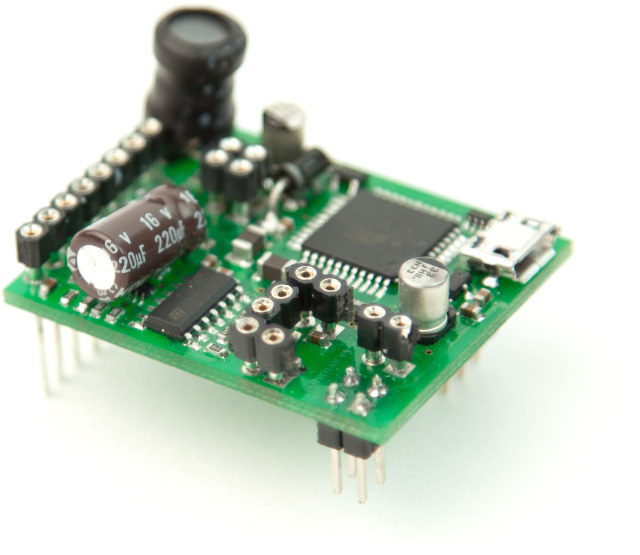We’ve already seen ultra cheap (and low end) electronics lab tools like DSO138 oscilloscope kit for $23, or the $5 USB123 USBee AX logic Analyzer, but EspoTek Labrador combines 5 electronics lab equipments into a single board that claims to act as an oscilloscope, a waveform generator, a variable power supply, a logic analyzer and a multimeter for just $25.
 EspoTek Labrador specifications and key features:
EspoTek Labrador specifications and key features:
- MCU – Atmel ATXMEGA32A4U 8-bit AVR MCU @ 32 MHz with 32KB flash, 4KB SRAM, and 1024 bytes EEPROM
- Functions
- 2 channels oscilloscope up to 750ksps, ~100kHz bandwidth, -20 to +20 V range
- 2 channels waveform generator up to 1 MSPS supporting sinusoidal, square, triangular, sawtooth, and arbitrary waveforms
- 4.5 to 15V power supply up to 1.5W max
- 2 channels logic analyzer up to 3 MSPS per channels
- Multimeter with voltage, intensity, resistance, and capacitance functions
- USB – micro USB port to connect to PC / board running software
- Power Input – 5V via micro USB port
- Dimensions – 38 x 31 mm
- Weight – 10 grams
The board needs to connected to a Windows, Mac OS X, or Linux computer via its micro USB port in order to be controlled by the custom software provided by the company and demonstrated in the video below in all 5 modes. Hardware files and source code can be found in Github.
The Labrador project is fundraising now on crowdfunding platform CrowdSupply, where it has raised 66% of it’s $9000 goal so far. You’ll need to pledge $25 for the Labrador, and discount are available for larger quantities. Shipping is already included in the pledge, the campaign ends on October 20th, and the boards are expected to ship before the end of the year.

Jean-Luc started CNX Software in 2010 as a part-time endeavor, before quitting his job as a software engineering manager, and starting to write daily news, and reviews full time later in 2011.
Support CNX Software! Donate via cryptocurrencies, become a Patron on Patreon, or purchase goods on Amazon or Aliexpress





Looks good.
If they would have Pay Pal…
What does the multimeter function intensity measure?
These things are all about the quality of the software that comes with them. Unfortunately I cannot see the video from Espotek because they posted it on Vimeo – and Vimeo is banned here in Indonesia for being “Immoral”. (why didn’t they post in parallel to YouTube?)
100 kHz bandwidth with a sample rate of 750 kbps (shared) – as per the data sheet on CrowdSupply – is really pushing it (assuming each channel gets 750/2 = 350 ksps). I would say they would be lucky to get around 85 kHz bandwidth (you’re NOT going to get a decent experience anywhere close to the half sample rate Nyquist bandwidth in reality). And why don’t they allow you to turn one channel off and get double the sample rate (which would double the bandwidth)? Maybe the problem is the software USB stack in the ATMega32A4U is just too slow. There’s no display to service, but they do have to service USB in real time. The old ATMEL ATMega 8 based JYE Tech scopes used to get more bandwidth, and they had to service a decent real-time graphic display. Something doesn’t feel right about the low oscilloscope bandwidth. I can’t help but think it’s the USB stack that’s holding it back. If it is, then they probably should have gone for a jellybean USB/UART chip instead, they cost just pennies (as long as you stay away from FTDI). Even a second USB/UART dedicated ATMega32A4U would have been a better solution.
This looks like a poor implementation of the Xprotolab:
http://www.gabotronics.com/oscilloscopes/xprotolab-plain.htm